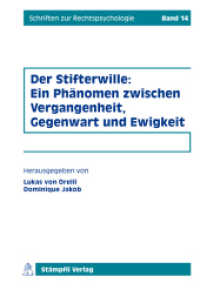Full Description
Over the past ten years, the study of mobility has demonstrated groundbreaking approaches and new research patterns. These investigations criticize the concept of mobility itself, suggesting the need to merge transport and communication research, and to approach the topic with novel instruments and new methodologies. Following the debates on the role of users in shaping transport technology, new mobility research includes debates from sociology, planning, economy, geography, history, and anthropology.
This edited volume examines how users, policy-makers, and industrial managers have organized and continue to organize mobility, with a particularly attention to Europe, North America, and Asia. Taking a long-term and comparative perspective, the volume brings together thirteen chapters from the fields of urban studies, history, cultural studies, and geography. Covering a variety of countries and regions, these chapters investigate how various actors have shaped transport systems, creating models of mobility that differ along a number of dimensions, including public vs. private ownership and operation as well as individual vs. collective forms of transportation. The contributions also examine the extent to which initial models have created path dependencies in terms of technology, physical infrastructure, urban development, and cultural and behavioral preferences that limit subsequent choices.
Contents
1. Introduction Christopher Kopper and Massimo Moraglio 2. Clashes of Cultures: Road vs. Rail in the North-Atlantic World during the Inter-War Coordination Crisis Gijs Mom 3. Half-Holiday Excursions and Rambling Clubs - How did Leisure Shape the Mobilities of the Early Twentieth Century? Jill Ebrey 4. Towards a Better Understanding of Bicycles as Transport Peter Cox 5. Mobile Worths: Disputes Over Streets Jim Conley 6. Urbanization and Transport Restructuring Before World War II: A Comparison Between London and Osaka Takeshi Yuzawa 7. Why the "Los Angelization" of German Cities Did Not Happen: The German Perception of U.S. Traffic Planning and the Preservation of the German City Christopher Kopper 8. Automobility, Utopia, and the Contradictions of Modern Urbanism, Concerning Karel Teige Steven Logan 9. The Conquest of Urban Mobility: The Spanish Case, 1843-2012 Alberte Martínez and Jesús Mirás 10. Shifting Transport Regimes: The Strange Case of Light Rail Revival Massimo Moraglio 11. The Creation and Perpetuation of an Automobile-Oriented Urban Form: Dispersed Suburbanism in North America Pierre Filion 12. Transportation Planning as Infrastructural Fix: Regulating Traffic Congestion in the Greater Toronto and Hamilton Area John Saunders 13. Move and Maintain: Mapping Multi-Local Lifestyles in Hyderabad, India Angela Jain and Gowkanapalli Lakshmi Narasimha Reddy 14. Dwelling In Between? Multi-Location between History and New Socio-Technical Systems Hans-Liudger Dienel and Massimo Moraglio






